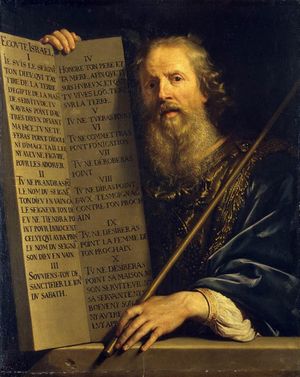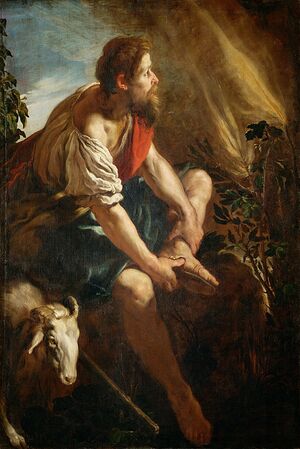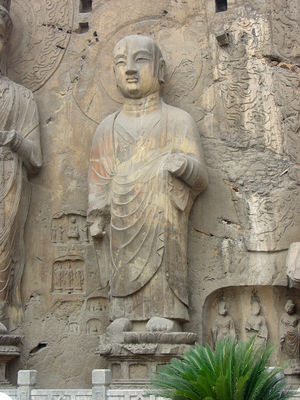Lord Ling/pt: Difference between revisions
(Created page with "''Moisés com os Dez Mandamentos'', Philippe de Champaigne (1648)") |
(Created page with "O '''Senhor Ling''' encarnou como '''Moisés''', entre meados do século quatorze e do século treze a.C. Nessa vida em que foi profeta, estadista e legislador hebreu, o Senho...") |
||
| Line 2: | Line 2: | ||
[[File:Philippe de Champaigne - Moses with the Ten Commandments - WGA04717.jpg|thumb|''Moisés com os Dez Mandamentos'', Philippe de Champaigne (1648)]] | [[File:Philippe de Champaigne - Moses with the Ten Commandments - WGA04717.jpg|thumb|''Moisés com os Dez Mandamentos'', Philippe de Champaigne (1648)]] | ||
''' | O '''Senhor Ling''' encarnou como '''Moisés''', entre meados do século quatorze e do século treze a.C. Nessa vida em que foi profeta, estadista e legislador hebreu, o Senhor Ling era inspirado pelo seu guru – um ser cósmico que patrocinava o povo hebreu – e por [[Micah]], o Anjo da Unidade. | ||
== Embodiments == | == Embodiments == | ||
Revision as of 04:08, 12 May 2020

O Senhor Ling encarnou como Moisés, entre meados do século quatorze e do século treze a.C. Nessa vida em que foi profeta, estadista e legislador hebreu, o Senhor Ling era inspirado pelo seu guru – um ser cósmico que patrocinava o povo hebreu – e por Micah, o Anjo da Unidade.
Embodiments
Moses
Moses was born about three hundred years after the death of Joseph, son of Jacob. At that time, the Israelites had multiplied in Egypt and become a large population. According to the book of Exodus, which tells the story of Moses, a pharaoh came to the throne who did not know Joseph. He enslaved the Israelites, but still their large population and strength troubled Pharaoh. He ordered all the Hebrews to cast every son who was born to them into the river.

When Moses was born, his mother hid him until he was three months old. Then she made an ark of bulrushes and put him in it. She put the ark in the river. Pharaoh’s daughter found Moses and took pity on him. Moses’ sister was standing by to watch him. She told Pharaoh’s daughter that she could find a Hebrew woman to nurse him. Then she went and got Moses’ own mother. Pharaoh’s daughter adopted the child and paid his mother to nurse him.
The Bible tells us that Moses “was learned in all the wisdom of the Egyptians, and was mighty in words and in deeds.”[1] In fact, he had performed great deeds of merit and passed many tests in previous lifetimes. His soul was chosen for the mission because he had proven himself.
Moses lived as an Egyptian of princely rank until he was about forty years old, when Exodus records that he “went out unto his brethren, and looked on their burdens: and he spied an Egyptian smiting an Hebrew, one of his brethren. And he looked this way and that way, and when he saw that there was no man, he slew the Egyptian, and hid him in the sand.”[2]
In this, Moses’ first act of public record, he took the law into his own hands and for the first time allowed his sympathy for the Hebrews to be known. Though God preordained Moses to “Let My People Go,” Moses was a man like other men, and God did not exempt him from the law of karma. For this and other reasons, Moses did not attain union with God at the end of his mission with the Israelites. God required him to reincarnate to balance his karma.

Moses fled Egypt to the land of Midian, where he lived for forty years. The Bible tells us that it was there that “the angel of the LORD appeared unto him in a flame of fire out of the midst of a bush: he looked, and behold, the bush burned with fire, and the bush was not consumed.” The LORD said, “I have seen the affliction of my people in Egypt, have heard their cry. I know their sorrows.” Then he commanded Moses: “Come now therefore, and I will send thee unto Pharaoh, that thou mayest bring forth my people the children of Israel out of Egypt.” Moses said, “When they ask me what is your name, what shall I tell them?” God said, “I AM THAT I AM: Thus shalt thou say unto the children of Israel, I AM hath sent me unto you.”[3]
After the land was smitten by ten plagues, the Egyptian pharaoh finally agreed to let the Israelites leave, and Moses led them on their journey through the wilderness to the Promised Land.
At one point in their journey, God called Moses to Mount Sinai for forty days and forty nights to receive the first set of tablets of the Law. But while he was there, the children of Israel rebelled against God and guru. These tablets were inscribed with the covenants that God would make with a holy people. They contained lengthy, detailed statements outlining the way a people sponsored by Sanat Kumara should follow the path of discipleship under the Law and under the guru.
The children of Israel were called to be a holy people, but they were not embodying the holiness of God at that time. In Moses’ absence, they worshiped the golden calf. When Moses descended the mountain and saw the people’s stubbornness and their embracing of the god of materialism, he broke the tablets. The detailed covenants were thereby lost and later replaced with ten simple commandments, which God inscribed on a second set of tablets. The people’s test would then be the “test of the ten,” which is the test of the solar-plexus chakra.[4]
After leading the children of Israel for forty years through the wilderness, Moses was not permitted to enter the Promised Land, but only to view it from Mt. Nebo just before his passing, because in anger he smote the rock to receive the waters rather than to lovingly invoke them and receive them.[5] And although he liberated the Hebrew people from Egyptian slavery, Moses did not balance his threefold flame, for his service was lacking in the quality of joy. His pink plume of divine love did not match the fiery intensity of his devotion to the will of God.

Ananda
In Moses’ next embodiment, as Ananda during the sixth century B.C., he became the disciple of Lord Gautama Buddha. Here, at the feet of the most advanced initiate on the planet, he learned how to render service in love and to tap the peace and understanding that come from within the golden flame of illumination.
Lord Ling
Following that embodiment, he lived in China as Lord Ling, one of the ruling class whose high attunement with the Brotherhood enabled him to serve his people through the balanced action of the threefold flame. At the close of that embodiment, he ascended to become the God of Happiness. He then devoted himself to the bright-gold flame of joy on behalf of all evolving upon this planet, for he recognized that without this quality, one cannot ascend nor render a just service unto God and man.
Reflections on his lives
Lord Ling has spoken of his embodiments as Moses and Lord Ling:
I myself did pass into another incarnation, and you have known me in my final embodiment as Lord Ling of China. There I perfected the wisdom, fulfilled the balancing of my karma and did espouse the flame of God-happiness. This I did in view of the great mourning and depression that is carried by so many of the children of Israel and Judah who have gone forth in a state of burden of their karma and in a state of depression concerning their absence of knowledge of the true path of salvation and the promise of heaven and victory on earth.
Some are even wed in a greater way to materialism than they were in the moments when we were in the wilderness and at the foot of Sinai. Yes, beloved, materialism and the pleasures of the senses are addictive. Far from getting better, these addictions get worse.
Thus, I engrave, as God does engrave in your hearts, the true mysteries of the kingdom, the true understanding of the requirements of the Law and the Path. If you are not able to read this writing, know that it does burn within you, that it is a living fire, that it is the fire infolding itself. It is the all-consuming fire of God that will, if you allow it, consume in you all those manifestations less than the fulfillment of the Law.
May you early seek the sacred fire and then the violet flame and then the calls unto the seven archangels. For those of you who have descended from this seed of Abraham, who also descended ultimately from the seed of Sanat Kumara, do indeed have a destiny in this hour; for your training in the ancient golden-age civilization of Jesus Christ does fit you to be true shepherds.
Thus, Jesus knew to whom he was speaking when he said, “Feed my sheep.”[6] There are those who are rightly able and called by their karma and destiny of dharma to feed the souls of the millions upon earth. I call you all to this calling, for you may be adoptive sons who have chosen to enter in to claim your joint heirship with Jesus of the sonship that does belong to all of this seed of light. Therefore, whether you are adoptive sons or count yourselves as those who truly trace their traditions to the beginnings, I am come to draw you into the office of the high calling of your destiny.[7]
His service today
God Ling maintains a focus of the flame of joy in the retreat of Jophiel and Christine in Central China. He often frequents this and other retreats of the Brotherhood, and he uses the flame of joy as a focus, a divine magnet, to draw mankind into the ascended masters’ consciousness. His momentum of great joy gives him a sense of the abundant life, the life holy and beautiful.
When invoking an abundant supply “of every good and perfect gift,” one should call to God Ling in addition to the God of Nature, the God of Gold and Fortuna, the Goddess of Supply.
Sources
Mark L. Prophet and Elizabeth Clare Prophet, The Masters and Their Retreats, s.v. “Ling, Lord (Moses).”
- ↑ Acts 7:22.
- ↑ Exod. 2:11–12.
- ↑ Exod. 3:2, 7, 10, 14.
- ↑ Sanat Kumara gives a detailed account of this episode in Moses’ mission in Elizabeth Clare Prophet, The Opening of the Seventh Seal: Sanat Kumara on the Path of the Ruby Ray, pp. 33–39.
- ↑ Num. 20:3–12.
- ↑ John 21:16, 17.
- ↑ Lord Ling, “The Code of Life for the Initiate,” Pearls of Wisdom, vol. 34, no. 32, June 30, 1991.
